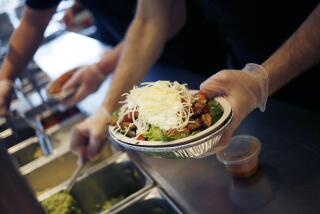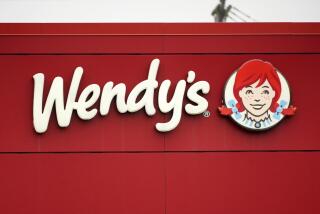McDonald’s monthly sales fall for first time in nine years
After more than nine years of monthly sales increases, McDonald’s Corp. finally felt the heat of competition and the sting of a difficult economy in reporting that revenue fell 1.8% last month.
Sales at stores open more than a year fell 2.2% from October a year earlier in the U.S. and Europe and sank 2.4% in the Asia Pacific, Middle East and Africa regions. Canada saw gains.
McDonald’s Chief Executive Don Thompson blamed the poor figures on “the pervasive challenges of today’s global marketplace.” But analysts said McDonald’s may just be getting too comfortable in its perch as the world’s largest restaurant chain.
Throughout the Great Recession and the slow recovery that hurt so many restaurant chains, McDonald’s flourished with its burgers and price-conscious Dollar Menu, its McCafe coffee line and premium salads, even gussied-up stores and updated ordering technology.
“But the momentum isn’t there anymore,” said analyst Nick Setyan at Wedbush Securities. “In a category that isn’t growing very much, they can’t keep developing at the same pace they have been.”
Quiz: How much do you know about California’s economy?
Now the chain’s seasonal favorite — the McRib sandwich — can’t appear on the menu soon enough. McDonald’s has said the McRib consistently contributes to strong fourth-quarter sales, although it doesn’t break out figures.
McDonald’s has suffered several uncharacteristic misses. The company said last month that its third-quarter profit tumbled 3.5% from the year-earlier period to $1.45 billion amid a stronger dollar and brutal U.S. competition. In the previous quarter, net income fell 4.5%. Still, same-store sales, a key measure of growth, rose 1.9% for the quarter.
McDonald’s tried to stem U.S. declines by advertising its value menu and launching new offerings, such as the premium Cheddar Bacon Onion sandwiches.
It also sought to engender consumer goodwill by voluntarily posting calorie counts on all menu boards and drive-throughs in the U.S. and launching a series of videos in Canada showing how it prepares its food and how it presents the food in advertising.
Those efforts haven’t helped the stock. McDonald’s shares fell $1.73, or 2%, to $85.13 on Thursday. So far this year the stock value has dropped 15%.
Last month, Thompson had cautioned analysts that the “declining consumer sentiment, high commodity and labor costs and heightened competitive activity” had created an “uncertain and fragile” environment, which he called the “new normal.”
Since the recovery, customers have become pickier and have demanded value for their dollar along with more healthful, premium food. A surge of new restaurants also created a bit of a glut, spreading consumer dollars thin.
And millennials — consumers ages 16 to 34 who were long the key demographic for fast-food companies — now prefer fast-casual options such as Panera Bread Co. and Chipotle Mexican Grill Inc., according to a report this week from the Boston Consulting Group and customer research firm Service Management Group.
The young demographic packs an economic wallop, eating out more often than older diners, spending more and usually bringing friends along too.
“Affordable fast-casual and fast-food restaurants with locally sourced goods, exotic flavors and service levels historically reserved for higher-quality restaurants will most likely garner a disproportionate share of millennial dining spending,” said Chris Egan, a coauthor of the report.
To stay relevant, national McDonald’s competitors, such as Burger King and Wendy’s, and regional chains, such as Jack in the Box and Sonic, have boosted their marketing spending and are reshaping their strategies.
Burger King revamped its stores, kicked out its unpopular monarch mascot, hired a slate of celebrity endorsers and upgraded its menu to compete with the Golden Arches. Last month the chain reported that global same-store sales increased 1.4% in its third quarter.
Wendy’s said Thursday that its same-store sales rose 2.8% in its third quarter.
The chain is outfitting its restaurants with a sleeker look and higher-end sandwiches, such as the Bacon Portabella Melt and the Asiago Ranch Chicken Club.
Sonic and Jack in the Box also have recently reported quarterly same-store sales growth of more than 2%.
“It’s a fight for the same pie,” analyst Setyan said. “The competitors have wisened up a bit and they’re all punching back, regaining the market share that McDonald’s took from them.”







